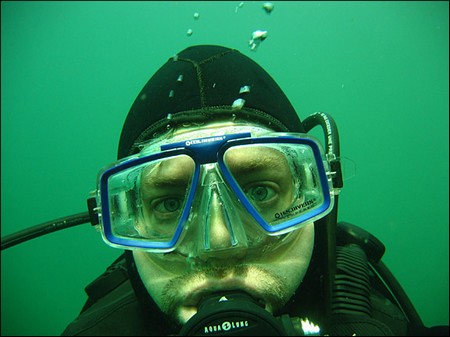Lakes and flooded quarries are favourite places for new divers to gain experience. They are unaffected by windy conditions and rarely have any currents. You can go diving in them whatever the weather. Some of them are stocked with fish, such as rainbow trout. However, large bodies of fresh water introduce other problems that a diver should be aware of.
Visibility
Some lakes may look idyllic at the surface with flat, calm water that reflects the blue sky. While lakes look very inviting, the diver often finds that the water in them is stained dark brown with peat and visibility is very poor. Most lakes have a muddy bottom and one touch with a fin, or the water thrust by a fin, can stir it up. Even a flooded slate quarry can have high levels of detritus and algae bloom. Be aware that diving in fresh water can mean diving in the dark.
The owners of many diving sites put in suspended platforms for trainee divers to kneel on while practising skills. These places can be very popular, especially on weekends, and a large number of divers means that visibility is more likely to be poor.
Low temperatures
One problem of diving in fresh water is the water temperature. The sea around the coasts of temperate countries rarely gets colder than 14°C (57°F), but the water in lakes can often be as cold as 3°C (37°F).
Water conducts heat away from our bodies much faster than air – in fact, about 25 times faster. This means a diver in a wetsuit fully immersed in cold water is soon in danger of hypothermia. People who dive in cold, fresh water should be properly equipped in a drysuit with suitable layers of insulation under it and wear gloves.
Regulator problems
When gas is put under pressure, it produces heat. When it is depressurised, it loses heat. The air in your tank is at a pressure probably exceeding 200 bars (3,000 psi) at the start of a dive. At the first-stage of your regulator, the pressure drops to around 8-10 bars (116-145 psi) more than the pressure around you. At 30 m (100 feet), the ambient pressure is 4 bars (58 psi). This is a huge pressure drop and, as a result, the regulator will get very cold.
Fresh water freezes at 0°C (32°F). The temperature around the first-stage can be much lower than this. Ice can cause the regulator to malfunction, making it stick open. The huge flow of depressurised air has the same effect at the second-stage, resulting in an uncontrollable free-flow of air. You will be shown how to use a free-flowing regulator, but it still means ending the dive. It’s a good idea to dive with two independent regulators on two separate tank valves, either with twin cylinders or with a single cylinder that has an H-valve.
